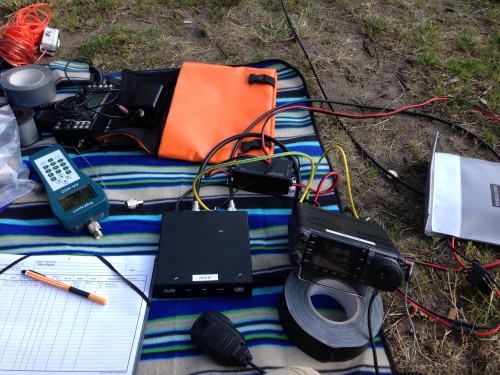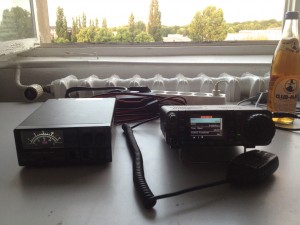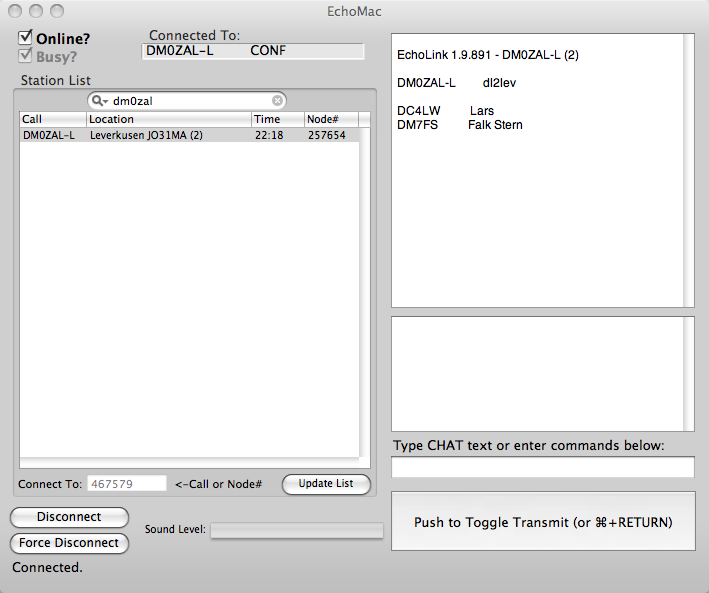I wanted to take part in the Berlin UrbanHamRadio activities with my own equipment. But I did not want to buy a new TRX for portable usage. My iCom IC-7000 is more or less portable – at least it fits in my backpack and can be powered with 12V.
After some research I found out, that I can use it with a standard Lithium-Polymer (LiPo) cell for RC racers. It costs about 50 EUR and if you don’t own a proper charger, you need to buy one as well (and a LiPo carrying bag). It’s a four cell LiPo with 14,4V voltage, which I can directly insert to the IC-7000 (it works best with 13.8V±15%, so from 11.7V up to 15.8V).

The LiPo is equipped with an EC5 plug, so I soldered the proper pins to the power cable for the IC-7000. The good thing about this LiPo: it can release up to 20 times its capacity as current. This is a 5Ah battery, so it can provide up to 100A for a short period of time. With RC racers this is needed for the start-up momentum. But I can also have some advantage during TX, when I want to use up to 100W of the TRX. Although the IC-7000 drains up to 22A at 100W transmit, I’m far away from any unsafe usage.
Talking about battery drains. Unfortunately the IC-7000 is equipped with a bright LCD and a lot of circuits. It’s far away from low power consumption. In idle receive mode it drains about 1.5A. With a battery of 5Ah I can use that for a bit more than 3 hours. Time drops rapidly with every transmit.

But it was time enough for several nice afternoons in the park! The small LEDs on the battery pack signal the remaining capacity. And we were lucky enough to bring a second battery pack just for the single time, when we wanted to end this QSO with Cornwall.
Unfortunately all the needed equipment is not portable enough for climbing on mountains. I need at least the IC-7000 (2.5kg), the battery pack (500g), the power connector (500g), probably the external tuner (700g), antenna and cables (4kg). So already about 10kg of stuff. But it’s okay for the city and carrying around on my bike and having a nice Sunday afternoon in the park!
After several years I bought my first HF Transceiver: an ICOM IC-7000. All my other transceivers work on 2m/70cm only, so nothing for long range communication.

My reasons were:
- I know that device from friends, so I’m basically used to the usage
- portable size for carrying in my rucksack along with my laptop for digimodes (although I have to carry a 13.8V power supply, it still fits into one bag)
- quite large hackvalue with a lot of ports and description in the manual
- fits for digimodes and can be controlled from a computer
- there is a composite output for the display, so that I can attach a projector and use the device for workshops
- with the release of the successor, the IC-7100, the IC-7000 dropped in price
I’m still in need of a good antenna for 15m/20m/40m/80m, but a transceiver is necessary for the start!
Yesterday evening I received a message from DO3BOX who asked me, if I can receive the Echolink entry point in Leverkusen DMØZAL-L on 423.850 MHz. Unfortunately I was in a basement at that time and so I had to wait until I get home.
The primary function of Echolink is known to me. But I never used it with a real transceiver, only with software from a PC. I read some websites about how I can reach the station with my transceiver and found out, that most of the Echolink entry points are working on simplex-mode at the HF-side (which makes sense…). I tried to reach the station, but got no reply. How should I provoke a signal from the station?
After some time the station sent out its callsign in CW. But I wanted to hear some „real“ voice! I searched at the net for an Echolink-software for my Laptop, a MacBook Pro with Mac OS X 10.5 on it. And I was really suprised that I found EchoMac! You can find tons of Windows software when you want to use your PC for some ham radio activities. And there are also some Linux applications which are quite usable. But finding a Mac application is really seldom and finding one with a nice interface is even deluxe!
I quickly filled out the preferences (good that I am already registered) but stuck at the point where I had to enter my password for using the Echolink-service from the internet. It’s more than a year ago when I used it for the last time. And at that time I had a different PC which is already out of order. I tried some passwords and had luck with the third entry 🙂 . Using EchoMac is really easy and so I quickly found DMØZAL-L on the list. I joined the station, but nothing happened. Well, I forgot to forward the UDP-ports 5198 and 5199 to my Mac… After fixing this on the router, I could connect to the station and no second later my transceiver said, that I connected via Echolink. I was impressed!

EchoMac in conversation with DM7FS and DC4LW on DM0ZAL-L
Tonight I did another try with DO3BOX and we even managed to get Falk DM7FS into the conversation. DO3BOX connected via HF which I tried first as well, but Leverkusen is too far away for a good 70cm transmission with my 5W handheld transceiver – although I could receive the signal quite good. So I switched to the PC, had to adjust the microphone signal and use some headphones for better listening. But it was still too noisy. I am wondering about the fact, that the signal is better on the right earplug, although it should be a mono-transmission. But testing equipment is one of the major parts doing ham radio and so I am not disappointed that our conversation was not that well 🙂
I need to buy a headphone with a microphone attached. Good that the MacBook Pro has separated plugs for AF-in and -out.



